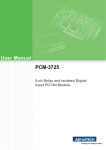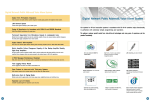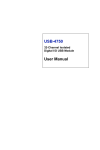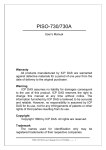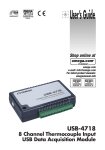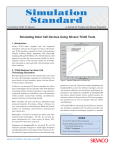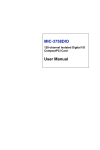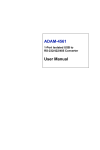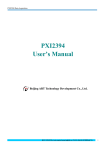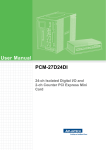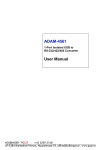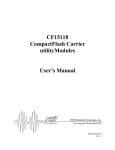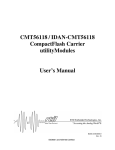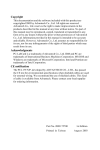Download PCM-3761I User Manual
Transcript
PCM-3761I 8-ch Relay and Isolated Digital Input PCI-104 Module User Manual Copyright This documentation and the software included with this product are copyrighted 2008 by Advantech Co., Ltd. All rights are reserved. Advantech Co., Ltd. reserves the right to make improvements in the products described in this manual at any time without notice. No part of this manual may be reproduced, copied, translated or transmitted in any form or by any means without the prior written permission of Advantech Co., Ltd. Information provided in this manual is intended to be accurate and reliable. However, Advantech Co., Ltd. assumes no responsibility for its use, nor for any infringements of the rights of third parties which may result from its use. Acknowledgments PC-LabCard is a trademark of Advantech Co., Ltd. IBM and PC are trademarks of International Business Machines Corporation. MS-DOS and Windows are trademarks of Microsoft Corporation. Intel and Pentium are trademarks of Intel Corporation. CE Notification PCM-3761I developed by ADVANTECH CO., LTD., has passed the CE test for environmental specifications when shielded cables are used for external wiring. We recommend the use of shielded cables. This kind of cable is available from Advantech. Please contact your local supplier for ordering information. Part No: 2003M76101 2nd Edition Printed in Taiwan March 2009 PCM-3761I User Manual ii Product Warranty (2 years) Advantech warrants to you, the original purchaser, that each of its products will be free from defects in materials and workmanship for two years from the date of purchase. This warranty does not apply to any products which have been repaired or altered by persons other than repair personnel authorized by Advantech, or which have been subject to misuse, abuse, accident or improper installation. Advantech assumes no liability under the terms of this warranty as a consequence of such events. Because of Advantech’s high quality-control standards and rigorous testing, most of our customers never need to use our repair service. If an Advantech product is defective, it will be repaired or replaced at no charge during the warranty period. For out-of-warranty repairs, you will be billed according to the cost of replacement materials, service time and freight. Please consult your dealer for more details. If you think you have a defective product, follow these steps: 1. Collect all the information about the problem encountered. (For example, CPU speed, Advantech products used, other hardware and software used, etc.) Note anything abnormal and list any onscreen messages you get when the problem occurs. 2. Call your dealer and describe the problem. Please have your manual, product, and any helpful information readily available. 3. If your product is diagnosed as defective, obtain an RMA (return merchandize authorization) number from your dealer. This allows us to process your return more quickly. 4. Carefully pack the defective product, a fully-completed Repair and Replacement Order Card and a photocopy proof of purchase date (such as your sales receipt) in a shippable container. A product returned without proof of the purchase date is not eligible for warranty service. 5. Write the RMA number visibly on the outside of the package and ship it prepaid to your dealer. iii Technical Support and Assistance Step 1. Visit the Advantech web site at www.advantech.com/support where you can find the latest information about the product. Step 2. Contact your distributor, sales representative, or Advantech's customer service center for technical support if you need additional assistance. Please have the following information ready before you call: - Product name and serial number - Description of your peripheral attachments - Description of your software (OS, version, software, etc.) - A complete description of the problem - The exact wording of any error messages Packing List Before setting up the system, check that the items listed below are included and in good condition. If any item does not accord with the table, please contact your dealer immediately. • 1 x PCM-3761I • 1 x CD-ROM • 1 x Startup Manual Safety Precaution - Static Electricity Follow these simple precautions to protect yourself from harm and the products from damage. 1. To avoid electrical shock, always disconnect the power from your PC chassis before you work on it. Don't touch any components on the CPU card or other cards while the PC is on. 2. Disconnect power before making any configuration changes. The sudden rush of power as you connect a jumper or install a card may damage sensitive electronic components. PCM-3761I User Manual iv Contents Chapter 1 General Information ....................................... 2 1.1 1.2 1.3 1.4 Chapter Chapter Introduction ....................................................................... 2 Features ............................................................................. 2 Applications ...................................................................... 2 Pin Assignments................................................................ 3 2 Installation ....................................................... 6 2.1 2.2 2.3 Initial Inspection................................................................ 6 Unpacking ......................................................................... 6 Jumper Settings ................................................................. 7 2.4 Switch Settings.................................................................. 8 2.5 Board ID............................................................................ 8 2.6 Hardware Installation ........................................................ 9 Figure 2.1:Location of Connectors and Jumpers ........... 7 Table 2.1:Summary of SW1 Settings ............................ 8 Table 2.2:BoardID Setting (SW2) ................................. 8 3 Operation ....................................................... 12 3.1 3.2 Overview ......................................................................... 12 Isolated Digital Inputs ..................................................... 12 3.3 Relay Outputs.................................................................. 13 Figure 3.1:Isolated Digital Input Connection .............. 12 Figure 3.2:Relay Output Connection ........................... 13 Appendix A Specifications ................................................. 16 A.1 A.2 A.3 Isolated Digital Input....................................................... 16 Relay Output ................................. 16 General ............................................................................ 16 v Table of Contents PCM-3761I User Manual vi 1 CHAPTER 2 General Information Chapter 1 General Information 1.1 Introduction The PCM-3761I is a 8-ch relay actuator and 8-ch isolated digital input module that attaches to the PCI-104 connector on your CPU card or PCI104 module. 1.2 Features • 8 relay output channels and 8 isolated digital input channels • LED indicators to show activated relays • 8 Form C type relay output channels • Output status read-back • Retained relay output values when hot system reset • High-voltage isolation on input channels (2,500 VDC) • High ESD protection (4,000 VDC) • High over-voltage protection (70 VDC 1 minute) • Wide input range (5 ~ 30 VDC) • Interrupt handling capability • BoardID™ switch 1.3 Applications • Industrial On/Off control • Switch status sensing • Digital I/O control • Industrial and lab automation • SMT/PCB machinery • Semi-conductor machinery • PC-based industrial machinery • Testing & measurement • Laboratory & education • External relay driving PCM-3761I User Manual 2 1.4 Pin Assignments 3 Chapter 1 Signal Name Direction Description COMn OUTPUT Common pin for Relay n NCn OUTPUT Normally closed pin of Relay n NOn OUTPUT Normally open pin of Relay n IDInH INPUT Isolated digital input high, channel n IDInL INPUT Isolated digital input low, channel n NC None No Connection PCM-3761I User Manual 4 CHAPTER 2 2 Installation Chapter 2 Installation 2.1 Initial Inspection Before starting to install the PCM-3761I, make sure there is no visible damage on the card. We carefully inspected the card both mechanically and electrically before shipment. It should be free of marks and in perfect order on receipt. As you unpack the PCM-3761I, check it for signs of shipping damage (damaged box, scratches, dents, etc.). If it is damaged or fails to meet its specifications, notify our service department or your local sales representative immediately. Also, call the carrier immediately and retain the shipping carton and packing materials for inspection by the carrier. We will then make arrangements to repair or replace the unit. 2.2 Unpacking The PCM-3761I contains components that are sensitive and vulnerable to static electricity. Discharge any static electricity on your body to ground by touching the back of the system unit (grounded metal) before you touch the board. Remove the PCM-3761I card from its protective packaging by grasping the card's rear panel. Handle the card only by its edges to avoid static discharge which could damage its integrated circuits. Keep the antistatic package. Whenever you remove the card from the PC, please store the card in this package for its protection. You should also avoid contact with materials that hold static electricity such as plastic, vinyl and styrofoam. PCM-3761I User Manual 6 2.3 Jumper Settings We designed the PCM-3761I with ease-of-use in mind. It is a "plug and play" card, i.e. the system BIOS assigns the system resources such as base address and interrupt automatically. The following section describes how to configure the card. You may want to refer to the figure below for help in identifying card components. Jumper JP1 Restores Ports to Their Condition Prior to Reset Jumper JP1 gives the PCM-3761I a new and valuable capability. With JP1 enabled (i.e., by shorting the lower two pins of JP1), the PCM-3761I "memorizes" all port I/O settings and output values, and, in the event of a "hot" reset, the settings and output values present at the port just prior to reset are restored to each port following reset. Depending on the application, this capability may allow a card to be reset without requiring a complete shutdown of processes controlled by the card (since port values are left unchanged and are interrupted only momentarily). Complete loss of power to the chip clears chip memory. Thus, even if JP1 is enabled, if the power to the card is disconnected, the card's initial power-on state will be its default state. When jumper JP1 is not enabled, both power-off and reset results in ports returning to their default states. Figure 2.1: Location of Connectors and Jumpers 7 Chapter 2 2.4 Switch Settings The appropriate REG, GNT, CLK and INT should be set to ensure your PCM-3761I work properly in the system. You can use SW1 to set these signals for expansion module, according to the table below. Table 2.1: Summary of SW1 Settings Switch Value 0 1 2 3 Module Slot 0 1 2 3 REG# REQ0 REQ1 REQ2 REQ3 GNT# GNT0 GNT1 GNT2 GNT3 CLK# CLK0 CLK1 CLK2 CLK3 INT INTA INTB INTC INTD 2.5 Board ID The PCM-3761I has a built-in DIP Switch that helps define each card's ID when multiple PCM-3761I cards have been installed. The board ID setting function is very useful when users build their system with multiple PCM-3761I cards. With correct Board ID settings, you can easily identify and access each card during hardware configuration and software programming.. Table 2.2: BoardID Setting (SW2) BoardID (DEC) 0* 1 2 3 4 5 6 7 8 9 10 11 12 13 14 15 * : Default PCM-3761I User Manual Switch Position ID3 ON ON ON ON ON ON ON ON OFF OFF OFF OFF OFF OFF OFF OFF ID2 ON ON ON ON OFF OFF OFF OFF ON ON ON ON OFF OFF OFF OFF 8 ID1 ON ON OFF OFF ON ON OFF OFF ON ON OFF OFF ON ON OFF OFF ID0 ON OFF ON OFF ON OFF ON OFF ON OFF ON OFF ON OFF ON OFF 2.6 Hardware Installation 1. Turn the PC’s power off. Turn off the power of any peripheral devices such as printers and monitors. 2. Disconnect the power cord and any other cables from the back of the computer. 3. Remove the system unit cover (see the users guide for your chassis if necessary). 4. Remove the CPU card from the chassis (if necessary) to gain access to the cards PCI-104 connector. 5. Connect connector J1 of the PCM-3761I card to the PCI-104 connector. Carefully align the pins with the PC-104 connector. Slide the module into the connector. The module pins may not slide all the way into the connector; do not force the pins into place, or the module may be damaged. 6. Fasten the module to the CPU card by using the included brass screw. Screw the brass spacer into the threaded hole on the CPU card. Do not tighten too much, or the threads may be damaged. 7. Attach any accessories to the PCM-3761I using 20-pin and 50-pin flat cables. 8. Reinstall the CPU card and replace the system unit cover. Reconnect the cables you removed in step 2. Plug in and turn on the power. This completes the hardware installation. Install the software driver as described in the following section. 9 Chapter 2 PCM-3761I User Manual 10 CHAPTER 3 2 Operation Chapter 3 Operation 3.1 Overview This chapter describes the operating characteristics of the PCM-3761I. The driver software bundled with this card allows users to access all of the card's functions without register level programming. Please see the User's Manual included on the driver CD-ROM for more information. 3.2 Isolated Digital Inputs The PCI-3761I has 8 isolated digital input channels designated IDI0~IDI7. Each of isolated digital input channel accepts 5~30 VDC voltage inputs. It accepts bi-directional inputs, which means you can apply positive or negative voltage to an isolated input pin(VIn). The figure below shows how to connect an external input source to one of the card's isolated input channels. Figure 3.1: Isolated Digital Input Connection PCM-3761I User Manual 12 3.3 Relay Outputs The initial relay out status of PCM-3761I is shown below: Figure 3.2: Relay Output Connection The "COMMON" line connects to the "NORMALLY CLOSED" line, if the corresponding bit is set as 0. Otherwise, if the corresponding bit is set as 1, then the "COMMON" line will connect to the "NORMALLY OPEN" line. Change of DO in the program will result in switch of the relay, in either direction. 13 Chapter 3 PCM-3761I User Manual 14 APPENDIX A 2 Specifications Appendix A Specifications A.1 Isolated Digital Input Channels 8 Optical Isolation 2,500 VDC ON Delay( L->H ) : 200us OFF Delay( H->L ) : 180us 70 V for 1 minute Logic 0 3V max. Logic 1 5V min.; 30V max. 1.31 mA @ 5V for each channel 9.66 mA @ 30V for each channel Opto-isolator response time Over-voltage Protection Input Voltage Input current A.2 Relay Output Channels 8 Relay Type Max. Switching Power Form C 30 VDC@1 A 125 [email protected] A 62.5 VA, 30 W Max. Switching Voltage 250 VAC, 220 VDC Max. Switching Current 2A Resistance Contact Max 50m ohm( at 1A 6VDC) Relay On Time 6 ms max. Relay Off Time 4 ms max. Insulation Resistance 1X109 ohm (at 500 V) Contact Rating A.3 General I/O Connector Type 20-pin box header x 1; 50-pin box header x 1 Dimensions 96 x 90 mm (3.8” x 3.5”) +5 V @ 105 mA (typical) +5 V @ 210 mA (max.) Power Consumption Operation Temperature 0~60° C (32~140° F) Storage Temperature -20~70° C (-4~158° F) Relative Humidity 5%~95% RH non-condensing PCM-3761I User Manual 16






















